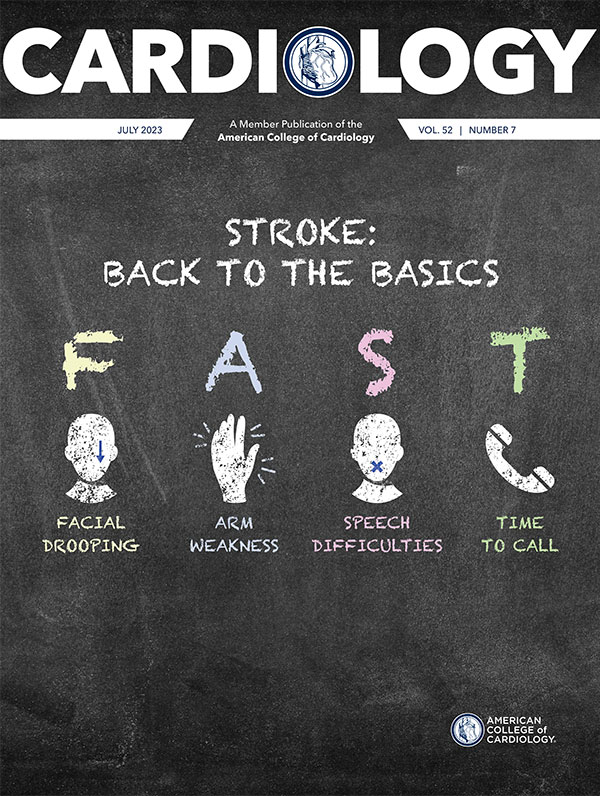Focus on EP | Heart Rhythm 2023: Five Takeaways
As a millennial, my decision to forgo attending in person the 44th Annual Heart Rhythm Society Scientific Sessions expectedly led to some "FOMO" (fear of missing out). However, the live virtual attendance experience was pleasantly surprising and I came out of the Heart Rhythm 2023 weekend ready to put into practice my top five takeaways from the program.


Pulse Field Ablation (PFA) Continues to Impress
The FARAPULSE system from Boston Scientific dominated the stage. Long-term safety and efficacy outcomes in 116 patients with paroxysmal atrial fibrillation (PAFib) who underwent PFA as part of the three first-in-human studies (IMPULSE, PEFCAT, PEFCAT II) were presented by Daniel Musikantow, MD.1 At a mean follow-up of four years, only 3.3% of patients had experienced an adverse event (no deaths) and 73% remained free of AFib/atrial flutter. Of note, use of the third-generation, optimized pulse waveform resulted in 81% freedom from AFib/atrial flutter.
The EU-PORIA registry provided real-world safety and efficacy outcomes in 1,233 patients with AFib who had PFA at seven high-volume centers in Europe. Notable procedural characteristics included deep sedation (avoidance of general anesthesia) in 80% of cases and an average skin-to-skin time of 58 minutes. According to Boris Schmidt, MD, who presented the data, major complications, including cardiac tamponade, stroke and TIA, occurred in 1.7% of cases.2 Minor complications occurred in 1.9%. One-year freedom from atrial tachycardia/AFib was 80% in PAFib cases, 66% in persistent AFib (PsAFib) cases, and 67% in longstanding PsAFib cases. Interestingly, operator experience did not affect clinical outcomes and prior cryoablation operators experienced less complications than prior radiofrequency ablation operators.

There's More to AFib Management Than Ablation
Oftentimes the effectiveness of an AFib ablation can be improved by optimizing conditions outside of the EP lab. In the LEAF study, Jeffrey Goldberger, MD, FACC, et al., randomized 59 patients with AFib and a BMI ≥27 kg/m2 to a standard risk factor modification regimen with or without the addition of liraglutide for three months before catheter ablation.3 Patients who had more weight loss had better outcomes. At six months post ablation, patients who lost ≥3% of their body weight, compared with <3%, experienced significantly greater freedom from AFib (88% vs. 61%: p=0.046). In the subset of patients with PsAFib, among those who lost more weight, there was a trend towards greater freedom from AFib at six months compared with those who lost less (90% vs. 61%; p=0.058).
In the MONITOR-AF study, Dhanunjaya Lakireddy, MD, et al., evaluated the impact of AFib management in 1,152 patients who underwent rhythm monitoring with an implantable loop recorder against 1,306 patients who underwent rhythm monitoring with routine monitoring tools (EKG, Holter, event monitors).4 Compared with patients who underwent routine monitoring, those with implantable loop recorders were significantly more likely to undergo AFib ablation (94% vs. 59%; p<0.05), had less delay to the first AFib ablation (average 153 vs. 426 days; p<0.05), and experienced greater freedom from AFib at 12 months (85% vs. 62%; p<0.05).

Conduction System Pacing Gains Even More Momentum
In patients who require CRT, conduction system pacing (CSP) is no longer being viewed as a noninferior alternative to traditional biventricular pacing (BVP), but instead a superior option.
From the HOT-CRT trial of 100 patients with a CRT indication randomized to either CSP (His pacing or left bundle branch atrial pacing [LBBAP]) or BVP, Pugazhendhi Vijayaraman, MD, FACC, et al., revealed that patients who underwent CSP experienced a significantly greater improvement in six-month post procedure left ventricular ejection fraction (LVEF) than those who underwent BVP (incremental change +12% vs. +8%; p=0.02).5 There was no significant difference in freedom from major procedural complications (98% vs. 96%; p=0.62).
From an observational registry of 1,778 patients with a CRT indication who underwent BVP or LBBAP for CRT, Vijayaraman and colleagues demonstrated that the primary outcome of time to death or heart failure hospitalization was significantly lower in the LBBAP group compared with the BVP group (21% vs. 28%; p<0.001).6 Furthermore, compared with those in the BVP group, those in the LBBAP group had a significantly narrower paced QRS (average 128 vs. 161 ms; p<0.01) and greater improvement in post procedure LVEF (41% vs. 37%; p<0.001).
From a prospective multicenter study of 371 patients with a CRT indication who underwent LBBAP or BVP for CRT, Juan Diaz, MD, et al., also demonstrated a significant decrease in heart failure hospitalization in the LBBAP group compared with the BVP group (23% vs. 40%; p=0.02) and no difference in all-cause mortality (6% vs. 12%; p=0.19).7 Furthermore, compared with the BVP group, those in the LBBAP had significantly shorter procedural times (average 95 vs. 129 minutes; p<0.001), less fluoroscopy use (12 vs. 23 minutes; p<0.001), narrower paced QRS (124 vs. 149 ms; p<0.001) and greater improvement in LVEF (incremental change +8% vs. +4%; p<0.01).

A Promising Future For Leadless Devices
Ever since the first leadless cardiac implantable electronic device (CIED) was introduced over a decade ago, electrophysiologists have been exploring novel leadless solutions across all CIED platforms.
Daniel Cantillon, MD, FACC, et al., presented the safety and efficacy outcomes from a prospective, multicenter, single-arm study of 300 patients with conventional indications for dual-chamber pacing who underwent a dual-chamber leadless pacemaker implant with the Abbott Aveir system.8 Successful dual-chamber implant was achieved in 295 patients (98.3%). At the 90-day follow-up, 90.3% of patients were free of procedural complications, which exceeded the prespecified goal of 78% (p<0.001), and 90.2% of patients had a combined atrial capture threshold of ≤3.0 V at 0.4 ms and atrial sensing (P wave) threshold ≥1.0 mV, which exceeded the prespecified goal of 82.5% (p<0.001). The three most common complications were the occurrence of AFib (3.3%), intraprocedural device dislodgement (1.7%) and postprocedural device dislodgement (1.7%). Atrioventricular synchrony ≥70% was achieved in 97.3% of patients, which exceeded the prespecified goal of 83% (p<0.001).
Long-term safety and efficacy outcomes from the Extravascular ICD Pivotal study, a prospective, multicenter, single arm evaluation of a subcutaneous ICD plus anti-tachycardic pacing (ATP), found at the 18-month follow-up that 6.8% of the 274 patients received appropriate ICD therapy, including 3.9% of patients who received ATP.9 Paul A. Friedman, MD, FACC, and colleagues demonstrated that ATP was successful in 67.3% of episodes (35/52), which resulted in shock avoidance in 71% of those episodes (37/52; two episodes self-terminated after the inherent delay from ATP). Inappropriate shocks occurred 11.7% of patients, resulting in a one-year rate of 10.2%. Freedom from procedure- or device-related complications was 91.9%.
Promising results with the leadless ultrasound-based WiSE CRT system in patients who had been considered untreatable, high-risk or had not responded to CRT came from the SOLVE-CRT study, presented by Jagmeet Singh, MD, DPhil, FACC.10 The study design included 31 patients from roll-in, 108 patients from randomization and 75 patients from a single-arm enrollment. At six months, 81% of patients were free of procedural complications, exceeding the prespecified goal of 70% (p<0.001), and the average reduction in LV end-systolic volume was 16.4%, exceeding the prespecified goal of 9.3% (p=0.003). Additional evidence of reverse remodeling included a reduction in LV end-diastolic volume (average reduction 25.4 mL; p<0.001) and improvement in LVEF (average increase 5.2%; p<0.001). Notably, the WiSE CRT system utilizes a leadless LV electrode but does require a transvenous right ventricular pacing lead.

It's Time to Change the Design
The two most provocative late-breaking studies at Heart Rhythm 2023 challenged the paradigm of contemporary trial design.
A secondary analysis of the PULSED AF trial presented by Atul Verma, MD, FACC, et al., examined a novel metric of 12-month atrial arrhythmia (AA) burden, instead of the traditional metric of freedom from atrial arrhythmia ≥30 sec, in the 150 patients with PAFib and the 150 patients with PsAFib who underwent pulmonary vein isolation for PFA.11 An AA burden of <10% occurred in 87% of patients with PAFib and in 82% of patients with PsAFib – and this AA burden threshold was associated with a clinically meaningful improvement in quality of life in the PAFib group but not in the PsAFib group (quality of life improvement was seen in all PsAFib patients regardless of AA burden). Furthermore, an AA burden <10% was significantly associated with fewer repeat ablations and fewer cardioversions. Overall, the investigators concluded that an endpoint of AA burden was more clinically relevant than an endpoint of freedom from atrial arrhythmias.
Enrolling a more diverse population representing our patient panels is possible. The prospective observational BIO-LIBRA study established a 40% minimum enrollment of women in order to examine the benefit of ICD/CRT therapy in patients with nonischemic cardiomyopathy patients, a group where some differences in outcomes by sex have been suggested from previous research.12 Using their novel enrollment design, 48% of the BIO-LIBRA study population was women, compared with historical enrollment rates of 15-29% in CIED studies. Racial diversity was notable for 30% non-White patient enrollment and 10% Hispanic/Latino enrollment. Valentina Kutyifa, MD, et al., reported that at the mean follow-up of 2.27 years, the rate of all-cause death was 35% lower in women than men (13% vs. 19%; p=0.013) and the rate of ventricular arrhythmias was 44% lower (6% vs. 11%; p=0.019). Overall, the investigators highlighted the need for contemporary research studies to improve sexual and racial diversity of its study patients.

This article was authored by Edward Chu, MD, FACC (@Ed_Chu_MD), an electrophysiology attending physician in Miami, FL.
References
- Musikantow DR, Neuzil P, Anic A, et al. LB-456089-2 Long-term clinical outcomes of pulsed field ablation to treat patients with paroxysmal atrial fibrillation. Heart Rhythm 2023; May 16 Available here.
- Schmidt B, Bordignon S, Neven K, et al. LB-456091-3 European real world outcomes with pulsed field ablation in patients with symptomatic atrial fibrillation – Lessons from the EU-PORIA registry. Heart Rhythm 2023; May 16:Available here.
- Goldberger JJ, Mitrani RD, et al. LB-456089-1 Pre-ablation weight loss as a predictor of atrial fibrillation outcome in the liraglutide effect on atrial fibrillation (LEAF) study. Heart Rhythm 2023; May 16:Available here.
- Lakkireddy DR, Garg J, Ahmed A, et al. LB-456091-2 Dynamic data driven management of atrial fibrillation using implantable cardiac monitors – the MONITOR AF study. Heart Rhythm 2023; May 16:Available here.
- Vijayaraman P, Pokharel P, Subzposh FA, et al. LB-456087-3 HIS-Purkinje conduction system pacing optimized trial of cardiac resynchronization therapy versus biventricular pacing: a randomized controlled clinical trial (HOTCRT). Heart Rhythm 2023; May 16:Available here.
- Vijayaraman P, Sharma PS, Cano O, et al. LB-456099-1 Left bundle branch area pacing compared to biventricular pacing for cardiac resynchronization therapy: results from the international LBBAP Collaborative Study Group. Heart Rhythm 2023; May 16:Available here.
- Diaz JC, Sauer WH, Duque M, et a. LB-456088-3 Left bundle branch area versus coronary venous lead placement as the initial implant strategy for cardiac resynchronization therapy – results from the SYNCHRONY Collaborative Group. Heart Rhythm 2023; May 16:Available here.
- Knops RE, Reddy VY, Ip JE, et al; Aveir DR i2i Study Investigators. A dual-chamber leadless pacemaker. N Engl J Med 2023; May 20:Available here.
- Friedman PA, Murgatroyd FD, et al. LB-456087-2 Chronic safety and performance of the extravascular ICD: results from the Global EV ICD pivotal study. Heart Rhythm 2023; May 16:Available here.
- Singh JP, Rinaldi CA, Sanders P, et al. LB-456088-4 Safety and efficacy of a leadless ultrasound-based cardiac resynchronization pacing system in heart failure – results from the SOLVE-CRT study. Heart Rhythm 2023; May 16:Available here.
- Verma A, Haines DE, Boersma LV, et al. LB-456089-4 Influence of atrial arrhythmia burden on quality of life in patients undergoing pulse field ablation: a sub-study of the PULSED AF trial. Heart Rhythm 2023; May 16:Available here.
- Kutyifa V, Di Biase L, Prasad K, et al. LB-456090-1 Contemporary outcomes of non-ischemic cardiomyopathy patients with an implanted defibrillator or cardiac resynchronization therapy (BIO-LIBRA). Heart Rhythm 2023; May 16:Available here.
Clinical Topics: Arrhythmias and Clinical EP, Cardiac Surgery, Heart Failure and Cardiomyopathies, Implantable Devices, EP Basic Science, SCD/Ventricular Arrhythmias, Atrial Fibrillation/Supraventricular Arrhythmias, Cardiac Surgery and Arrhythmias, Cardiac Surgery and Heart Failure, Acute Heart Failure
Keywords: ACC Publications, Cardiology Magazine, Atrial Fibrillation, Cryosurgery, Body Mass Index, Ischemic Attack, Transient, Electrocardiography, Ambulatory, Atrial Flutter, Catheter Ablation, Tachycardia, Supraventricular, Stroke, Body Weight, Heart Failure, Electric Countershock, Arrhythmias, Cardiac
< Back to Listings

